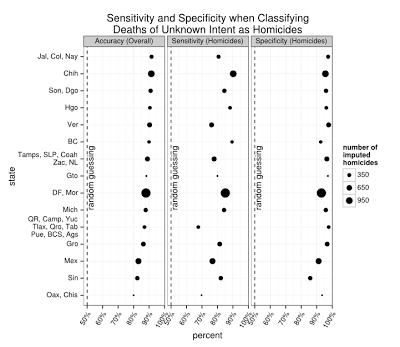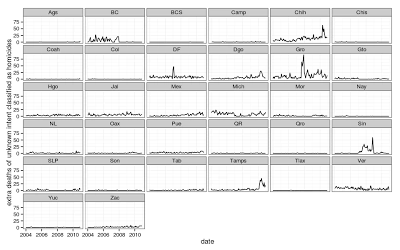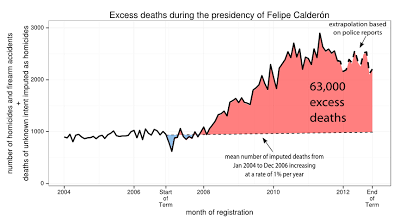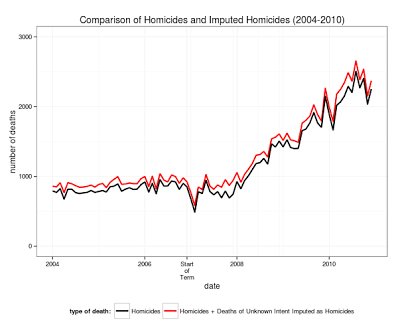There are newspapers and organizations that keep tallies of drug war-related deaths, which in itself is very laudable, but drug trafficking existed long before Calderón came to office and it will exist long after he leaves. Plus, there is also the issue that the government stopped publishing data on drug war-related deaths after September 2011, and its numbers usually came out higher than the private estimates.
To judge the events of the sexenio I’ll focus first on counting the total number of homicides as accurately as possible for a blog post, then setting a baseline and counting the number of excess deaths. To start, there’s the official INEGI data and SNSP data which everyone can access online. I’ll order the INEGI homicides by date registered (instead of date of occurrence) and add firearm accidents since they:
- Have been increasing
- As we saw in my last post sometimes they resemble homicides more than accidents.
| Year | INEGI Homicides | Firearm Accidents | Unknown Intent | Imputed INEGI Homicides | SNSP Homicide Reports† |
| 2004 | 9,328 | 366 | 2,957 | 10,339 | 11,658‡ |
| 2005 | 9,918 | 271 | 2,932 | 10,942 | 11,255‡ |
| 2006 | 10,449 | 265 | 2,793 | 11,414 | 11,775‡ |
| 2007 | 8,864 | 699 | 2,376 | 10,205 | 10,253 |
| 2008 | 14,005 | 555 | 2,567 | 15,246 | 13,193 |
| 2009 | 19,804 | 456 | 2,920 | 21,065 | 16,117 |
| 2010 | 25,757 | 630 | 3,594 | 27,508 | 20,681 |
| 2011 | 27,212 | 5,630 | 22,487 |
‡ The State of Mexico was registering accidental deaths as if they were homicides
Notice how deaths of unknown intent were on a downward trend up to 2008 when the trend reversed at the same time homicides surged. As I detailed in this post and in my post about classifying deaths of unknown intent in Ciudad Juárez they:
- Statistically resemble homicides and
- Explain some of the difference in under-reported homicide deaths when compared with drug war-related homicides.
To classify deaths of unknown intent I first recoded legal intervention / operations of war deaths as homicides, I then excluded deaths that occurred outside of Mexico. Because of the anomaly in the Federal District I recoded all accidental deaths during January and February of 2007 in this federate entity as unknown. In Sinaloa I recoded accidental deaths by firearm as unknown as I detailed in my previous post. And in Baja California I set all firearm accidents as deaths of unknown intent in 2007.
I still have lots of doubts about the vital statistics in Chiapas, but since it is not a state that has suffered the worst of the drug war I’ll leave it alone. Also the mass graves found in Guerrero seem to be missing from the data (add another 100?), but I’ll ignore it. And in Tamaulipas even including deaths of unknown intent under-counts drug war-related homicides, but again I’ll ignore it (add about another 200-400? homicides to my estimate).
I used linear discriminant analysis and k-nearest neighbours classify each and every death of unknown intent in the database (plus some accidents for the states I previously mentioned) taking into account the injury mechanism, and the age and sex of the victim. To make sure I wasn’t overfitting the data I calculated the sensitivity ans specificity for each state or group of states (some states are pretty small):
 |
| The accuracy refers to the overall accuracy of the classification of homicides, accidents and suicides. The sensitivity and specificity refer only to homicides |
I could have used fancier algorithms to try and get better classification performance, but the results were pretty good and I wanted something fast. Also take into account that since I have to use the raw data from the mortality database I only have data available up to 2010.
Here’s what the more accurate monthly homicide time series looks like:
 |
| Do note the increase in Tamaulipas |
There are a number of problems with my estimate:
- I used data on police reports from the SNSP, but if I used drug war homicide data from Milenio I would have goten much higher estimates since deaths during the first eleven months of each year increased from 11,343 in 2011 to 11,412 in 2012.
- The more or less arbitrary baseline is open to criticism. According to the Secretary of Interior Alejandro Poiré they found a country “infested by rats”. Calderón supporters would put the baseline much much higher than the one I used, though I have the feeling this is just an ad-hoc justification since they never provided any evidence for this. Then there is also the fact that the government considers most of the dead to have been criminals, so we have the president (in)famously stating “If you see dust in the air, it’s because we’re cleaning house,” supporters of the war would argue that those who lost their lives in a certain way deserved their fate.
- Saying that Mexico was on the verge of a drug war before the president took office is not the only view since each generation of Mexicans was becoming less violent before the drug war (though with important period effects), and Mexico had had episodes of localized drug violence before in mid-ninties in Ciudad Juárez and at the turn of the century in Tijuana without plunging into a extended drug war, so maybe the baseline is set too high.
I’m still missing mass graves that haven’t been found, and bodies that simply disappeared without leaving a trace. One could combine the various lists of disappeared kept by the PGR and SSP to produce an estimate of the number of missing persons in Mexico, but you would still have to match them somehow to the mortality datase since many o the dead are never fully identified. This means my estimate is a lower limit.

